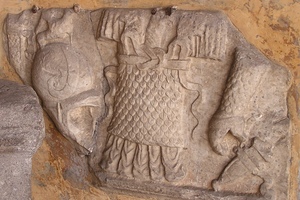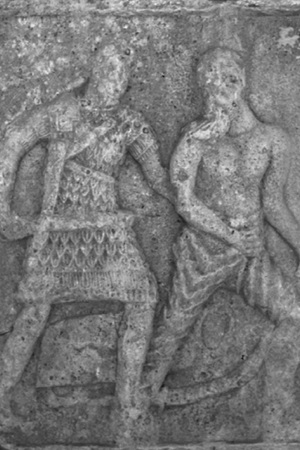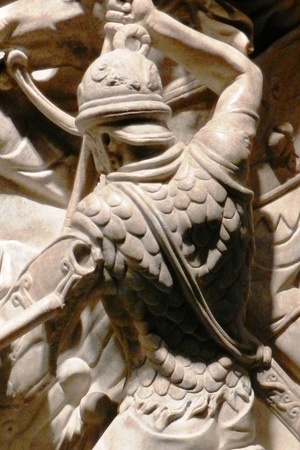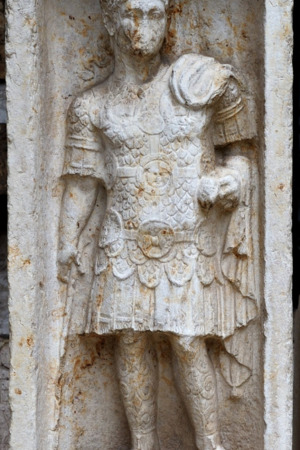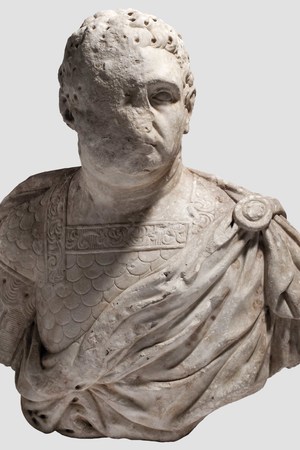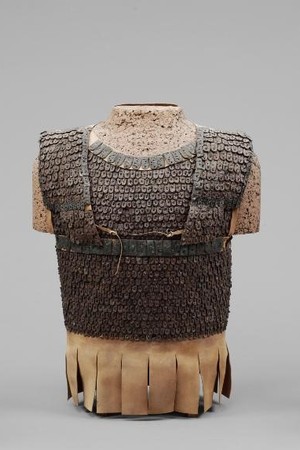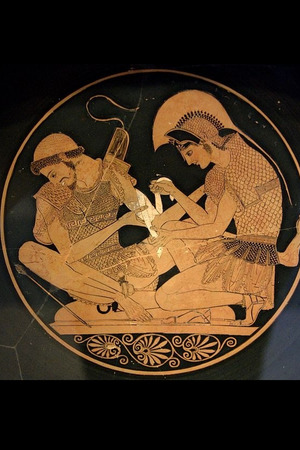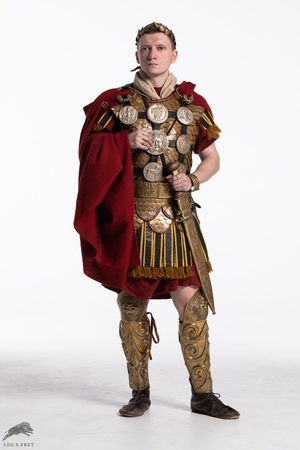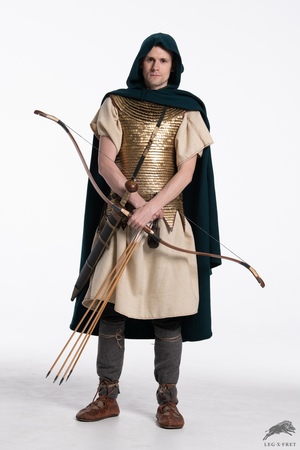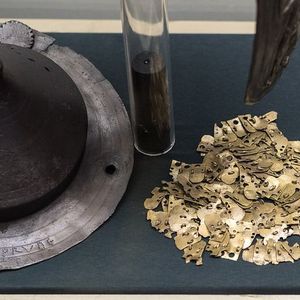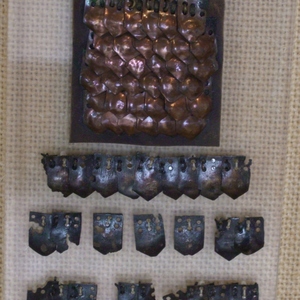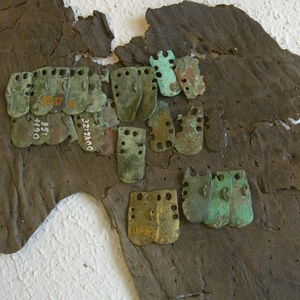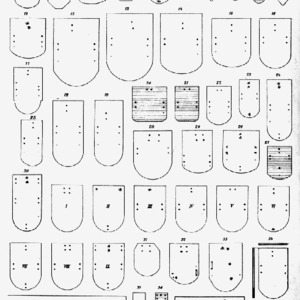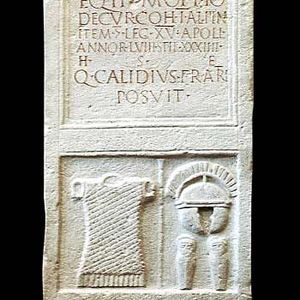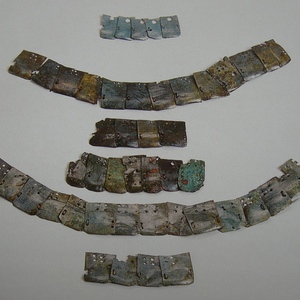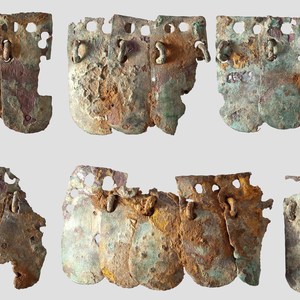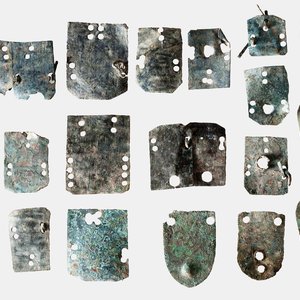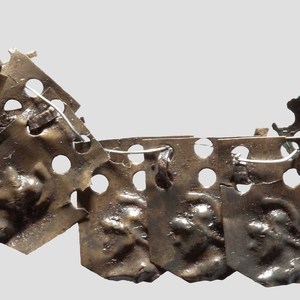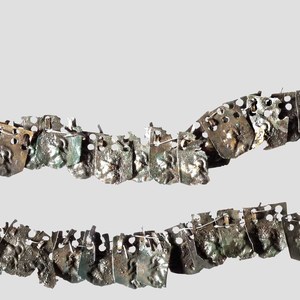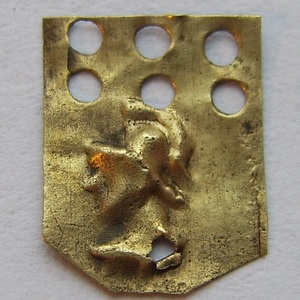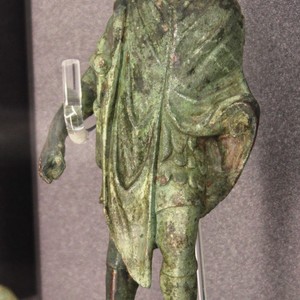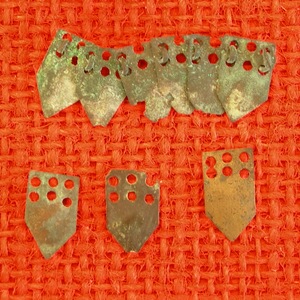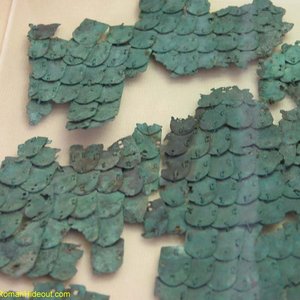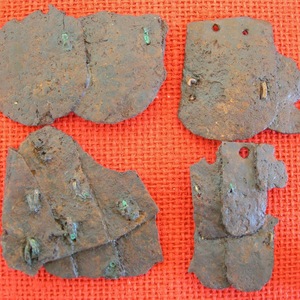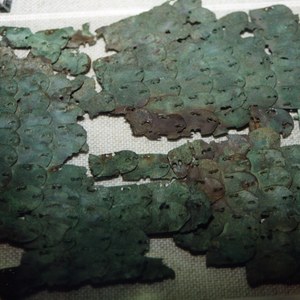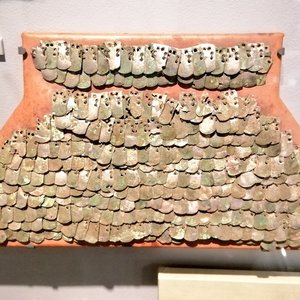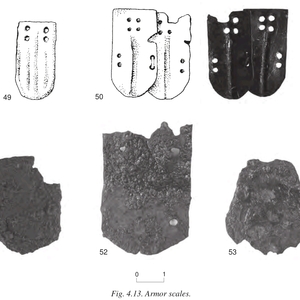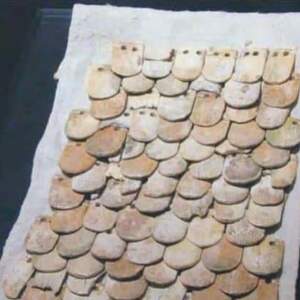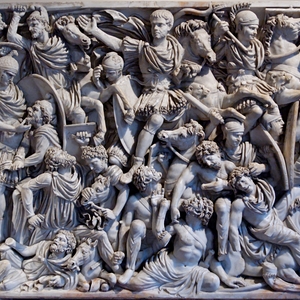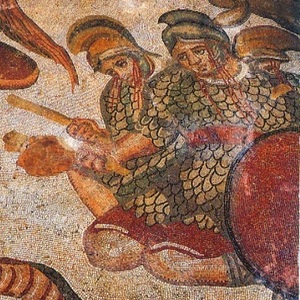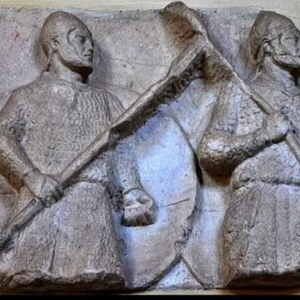Lorica squamata
Lorica squamata (lat. lorica squamata) — is a scale armor used in Roman army.
According to Rassel-Robinson the armor type was in use since early XVII BCE. Lorica squamata’s main feature is its design. Lorica squamata consisted form small metal plates, resembling fish scale structure or roofing tiles. Согласно Расселу-Робинсону, такой тип доспеха существует с начала XVII-века до н.э. Scales were connected by copper or iron wire, or by a lace, which went through pair of holes on the side of the every plate. Depending on a connection way (wire or a lace) scale armor was more or less flexible. Scales were usually attached to leather of fabric. Every scale had from 4 to 12 holes fro attaching to the closest raw. The scales dimensions were from 6.5×9.5mm to 5x8 cm. Mostly widespread scale dimensions were around 1.3x2.5 cm. Mostly, scales’ thickness was around 0.5-0.8 mm.
Scale armor stands quite well against blunt impacts and bow arrows. If a scale armor is properly done it also provides good protection against slashing and cutting. Scales provide better protection from slashing, than lorica hamata.
Typology
Though, there are a lot of different scale types, these are the most common scale types: rectangular (A), arched lancet (B), curved (C), small radius (D), bounded rectangle (E), and triangular (F). Additionally, to the type of scale form, scales varied in their cross-section dimension. Scales could be: flat (i), curved (ii), v-shaped (iii), single-ribbed (iv), and double-ribbed (v). Usually, such scales were made out of iron alloy or copper alloy, thought there can be scales made out of precious metals, like gold and silver. The combination of material, form and cross-section of a scale allows to easily determine the type of scale armor. This typology is sometimes enlarged because of the new archeological findings. Various scales made out of different materials, which have diverse shape and scale are a common archeological finding.
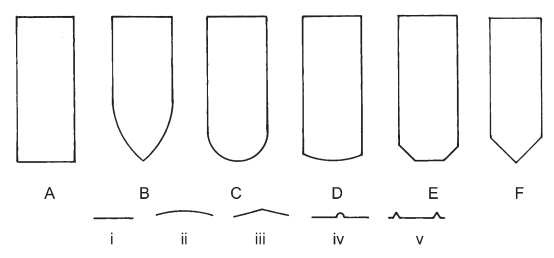 Squamata’s scale shape typology
Squamata’s scale shape typology
There are also other scales’ typologies, such as Maximilian von Groller-Mildans ' classification. It classifies armor scales of the first century according to the location of the attachment holes.
1-Carnutum Scales, 2-Ham Hill, 3-Campton, 4-Longthorpe, 5-Chichester
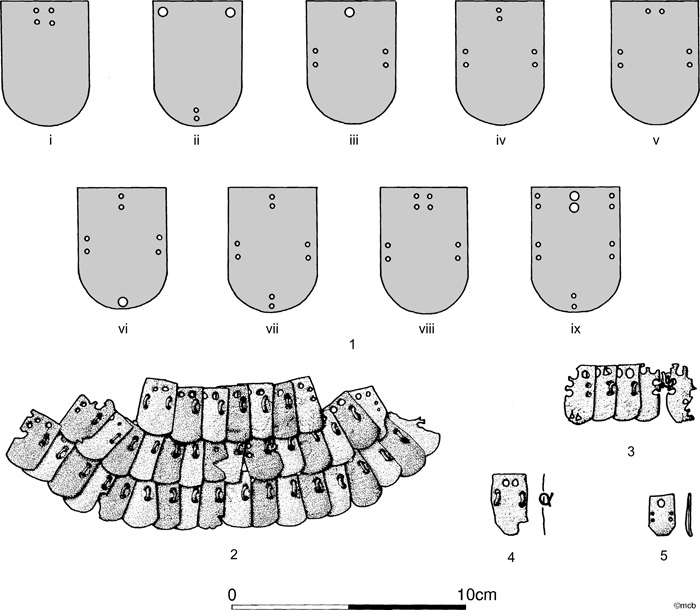 Squamata’s scale hole quantity typology
Squamata’s scale hole quantity typology
In archaeological finds, scales with a cross-section are most often found. The rigidity of a flat sheet can be significantly improved by adding corrugations, as can be seen on corrugated iron sheets and on corrugated paper. The stiffness can also be increased by changing the cross-section of the sheet from a flat section to a curved one. In addition, archaeologists have found decorated scales that are more ceremonial than military. So, as an example, you can give scales with a stamped image of Mars or Minerva. There are claims that the scaly armor or its individual parts could have been gilded or silvered.
There are a lot of found variations of scale armor. For example, on the Aquilifer’s tombstone from the Legion XI Claudia Pia Fidelis, you can see shoulder pads, also made of scales. Structurally they are similar to Lorica Hamata’s bindning. There are also reinforced shoulders on another officer's scale armor, depicted in the bas-relief from Civita Castellana (Ital. Civita Castellana, Lazio region, Vitreo, Italy, 1st century BC-early 2nd century CE).
Armor structure
To effectively protect, scale armor consists from two main structural layers: scales’ layer itself and the material between scale layer and a body.
The inner layer of the material or even several of them was necessary. Scale armor could tear the wearer’s skin, and connection wires could hurt him with its pointy ends. Obviously, it wasn’t a good idea to put on such scale armor without a protection layer. There are archeological findings, like a crystallized skin on the inner layer of a scales, extracted from Carlisle, which confirms the fact, that there must be a significant layer of a material between armor and a wearer to counter friction. There is an additional confirmation for that idea – the findings of lorica squamata from Carnuntum, Germany. That lorica squamata had preserved pieces of leather and a coarse fabric.
Scales’ overlapping is playing a significant protection role – it significantly increases medium protection thickness of a scale armor. This means, that scale armor thickness varies depending on the overlapped layers. There is one possible configuration of scales overlapping on the image below. Scales on the image are connected from four sides, so these scales are overlapped from every side.
 Variation of the squamate structure
Variation of the squamate structure
This scale armor variant has places with single layer (11%), two layers (68%) and four layers (21%). Such scale overlapping significantly increase armor protection.
 A variation of squamata with marks showing scales overlaps
A variation of squamata with marks showing scales overlaps
Field maintenance
Scale armor can suffer significant damage in combat and still be functional. Bent scales could be removed, set straight and could be placed on the same space. That scales would offer the same protection as before.
Krum suggested, that lorica squamata could be repaired in field. However, there are found squamata scales that damaged, that in order to restore scale armor protection one had to change the scales entirely. Thought, it has no plausible evidence, whether such amour was used or not. It is also questionable, whether soliders had spare scales of parts to repair squamatas. It is highly probable, that significantly damaged, irreparable squamatamas, were disassembled for spare parts: scales stripped and reused for repairs.
Usage
Roman army used lorica squamata from 1 century CE But lorica squamata became really widespread during Severan dynasty. The whole empire, a lot of different military branches very frequently used lorica squamata. There is evidence, that legionaries, auxiliary and cavalry used scale armor.
Additionally, according to tombstones, not only common legionaries used lorica squamata. There is evidence, that centurions and aquilifers used scale armor. Moreover, there are images of emperors, who used lorica squamata. For example – the Image of Vitelie in lorica squamata. This gives a ground, that lorica squamata was very versatile armor. Lorica squamata was particularly widespread on the east side of Empire.
Scale armor in Hellas
It should be said, that scale armor was used before romans, in ancient Greece. Such scale armor resembled linothorax, but was composed out of scales. There are many images of hoplites wearing such scale armor on ancient Greek pottery.
Reenactment
Lorica squamata would fit for a variety of different roman characters to reenact: any roman legionary, auxiliary, cavalry or even emperors can wear lorica squamata. It’s highly recommended to use the mostly wide spread material for scales – different copper alloys (usually brass). Wearing scale armor is like something between lorica hamata and lorica segmentata, the same applies in terms of transporting and storing. If a scale armour is properly fitted, lorica squamata can be even more comfortable than lorica hamata. Another advantage of wearing lorica hamata is an opportynity to wear it with something beneath (like subarmalis) or without it, as usually scales are sewed on a solid piece of leather. It’s also should be mentioned, that scales could be attached not only to leather, but to a fabric. Speaking about a period – lorica squamata can be used for reenactment from mid-to-late I century to early II century. In terms of protection – scale armor is slightly worse than lorica segmentata in terms of withstanding penetrating blows, as well as overall protection. Lorica segmentate offers better shoulder protection than lorica squamata. For reenactors the biggest drawback of scale armor is production complexity, which leads to a significant price.
Similar topics
Legion, Lorica Segmentata, Lorica hamata, Lorica, Legionnary, Aquilifer, Centurion,Hoplite,Linothorax
Literature
- D. Sim and J. Kaminski Roman imperial armor: the production of early imperial military armor. Published by Oxbow Books, Oxford, UK
- Bishop, M. C. and Coulston, J. C. N. (1993) Roman Military Equipment: from the Punic Wars to the fall of Rome. Batsford: London.
- Robinson, H. R. (1975) Armour of Imperial Rome. Arms and Armour Press: London

 Gallery
Gallery






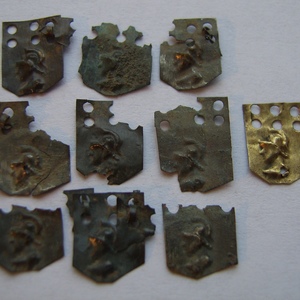 A series of rare ornamented scales with Mars’ and Minervas’ heads: thickenss 0.25 mm, broadness 8 mm, length 10mm, from a private collection. Approximately 60s CE
A series of rare ornamented scales with Mars’ and Minervas’ heads: thickenss 0.25 mm, broadness 8 mm, length 10mm, from a private collection. Approximately 60s CE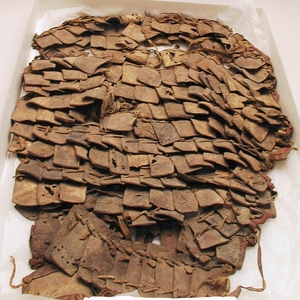 A rare sample of loriqa squamata from Dura-Europos, covered in leather. Separate scales are connected with strings, going through specific holes on a soft leather and fabric basis, The Yale University Art Gallery-U.S.A., approximately II-III century CE
A rare sample of loriqa squamata from Dura-Europos, covered in leather. Separate scales are connected with strings, going through specific holes on a soft leather and fabric basis, The Yale University Art Gallery-U.S.A., approximately II-III century CE
